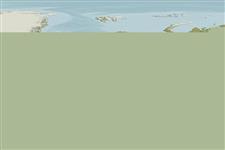Classificação / Names
Nomes comuns | Sinônimos | Catalog of Fishes(Gênero, Espécies) | ITIS | CoL | WoRMS | Cloffa
>
Ophidiiformes (Cusk eels) >
Ophidiidae (Cusk-eels) > Ophidiinae
Etymology: Ophidion: Diminutive of Greek, ophis = serpent (Ref. 45335); saldanhai: Named in honor of the Portuguese ichthyologist Luis Saldanha (Ref. 34017).
Environment: milieu / climate zone / depth range / distribution range
Ecologia
marinhas demersal; intervalo de profundidade 31 - 37 m (Ref. 34017). Tropical
Eastern Central Atlantic: known only from Cape Verde and the Gulf of Guinea.
Tamanho / Peso / Idade
Maturity: Lm ? range ? - ? cm
Max length : 15.0 cm SL macho/indeterminado; (Ref. 34017)
Descrição suscinta
Morfologia | Morfometria
Espinhos dorsais (total): 0; Raios dorsais (total): 117; Espinhos anais 0; Raios anais : 105 - 106. Color of fresh holotype: Pale pink, with a silver to golden stripe all along middle body, and a more silvery area a the preopercular region, behind and under the eye. The dorsal portion of the head (snout and nape) and of the body was slightly darker. Belly pigmentation whitish. The margins of the dorsal and anal fins were edged in white; blackish subterminal stripe, darker at the rear of the fins. Black pupil and iris reddish to silvery, with a black blotch at the dorsal portion (Ref. 34017).
Reproductive strategy possibly similar to other members of this family featuring oviparity, with oval pelagic eggs floating in a gelatinous mass (Ref. 205).
Ciclo de vida ou comportamento de acasalamento
Maturidade | Reprodução | Desova | Ovos | Fecundidade | Larvas
Matallanas, J. and A. Brito, 1999. Description of Ophidion saldanhai sp. nov. from the Cabo Verde Islands. J. Fish Biol. 55(5):931-936. (Ref. 34017)
Status na Lista Vermelha da UICN (Ref. 130435)
Ameaça para os humanos
Harmless
Uso pelos humanos
Mais informação
Nomes comunsSinônimosMetabolismoPredadoresEcotoxicologiaReproduçãoMaturidadeDesovaAgregação de desovaFecundidadeOvosDesenvolvimento dos ovos
Idade/TamanhoCrescimentoPeso-comprimentoComprimento-comprimentoFrequências de comprimentoMorfometriaMorfologiaLarvasDinâmica larvalRecrutamentoAbundânciaBRUVS
ReferênciasAquaculturaPerfil para aquaculturaEstirpesGenéticaElectrophoresesHereditariedadeDoençasProcessamentoNutrientsConversão de massa
ColaboradoresFotosStamps, Coins Misc.SonsCiguateraVelocidadeTipo de nataçãoÁrea branquialOtólitosCérebrosVisão
Ferramentas
Relatórios especiais
Baixar XML
Fontes da internet
Estimates based on models
Preferred temperature (Ref.
123201): 16.6 - 27, mean 19.5 °C (based on 25 cells).
Índice de diversidade filogenética (Ref.
82804): PD
50 = 0.5000 [Uniqueness, from 0.5 = low to 2.0 = high].
Bayesian length-weight: a=0.00102 (0.00046 - 0.00225), b=3.06 (2.88 - 3.24), in cm total length, based on all LWR estimates for this body shape (Ref.
93245).
Nível Trófico (Ref.
69278): 3.5 ±0.7 se; based on size and trophs of closest relatives
Resiliência (Ref.
120179): Elevada, tempo mínimo de duplicação da população menor que 15 meses (Preliminary K or Fecundity.).
Fishing Vulnerability (Ref.
59153): Low vulnerability (10 of 100).
